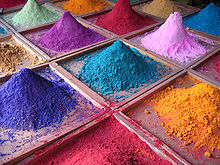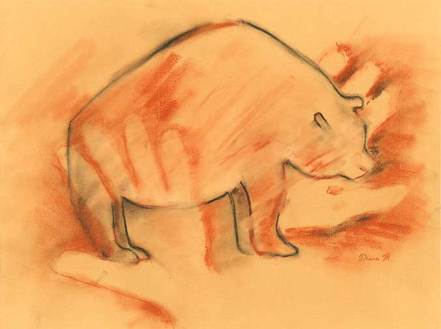The Art

Pigments for sale at a market stall in Goa, India.
The last ice age was called “The Great Ice Age” and was over 11,000 years ago. There have been eleven different ice ages, all taking place during the earth’s 4.6 billion years of history. During “The Great Ice Age” over a third of the earth was covered in ice. Possible reasons for the ice ages occurrence are that the temperatures were much colder, so it never rained; causing it to only snow and the possibility that the earth tilted away from the sun. During that point aside from our ancestors, there were woolly mammoth, woolly rhinos, cave bears, bison, wolves, horses, and herds of reindeer like modern day reindeer. Now that the woolly mammoth, cave bear, and woolly rhino are extinct it leads us to ask one question. How do we know that those animals ever existed in the first place? Well, the answer is caves (Snowtastic Snow).
People painted pictures of these animals on the sides of their caves and skeletons of the animals have been found in the caves (Snowtastic Snow). This started over 10,000 years ago. An ancestor took a stick from the fire and started the first charcoal drawing on the walls of a cave. The drawings were layered over the following thousands of years by repainting over the old, faded areas using natural earth pigments and blood. An artist named Ardis Harsche was inspired by her fellow Paleolithic artists. She applied charcoal, dry earth pigments, sand, and encaustic to represent the texture and look of the caves. “I wonder if those ancestors from the past would appreciate my effort to recreate the beginning of art”, she said (Harsche).
The cave painting idea came to me when I was looking at photographs of the cave paintings in France and I was really into texture at the time of my work. It really wasn’t the cave paintings that gave me the idea. It was really more that I wanted to try to make a hunk of the cave type of thing. And how can I do that? There was a waxy look to it and a sandy look to it. And so I remember when I was in college, about encaustic painting which is putting wax into your pigments”, she said (Harsche).
“I use a wax mixture and I have three different kinds of waxes and resin and the resin makes a nice hard surface when it’s done. It comes to the surface when it dries. My cave paintings are unique compared to other art work because it’s a very ancient medium and not very many people have seen it and it has a very translucent look to it. It really fascinates people because the first question is what is it? What type of paint? What kind of painting do you do? I don’t understand what this is. I like it because I almost feel like I’m a sculptor in a way because I can do a lot of texture. I can carve into it and find things you can do with wax. There are not any encaustic artists but there is a very good relationship between all of these artists” (Harsche).
People painted pictures of these animals on the sides of their caves and skeletons of the animals have been found in the caves (Snowtastic Snow). This started over 10,000 years ago. An ancestor took a stick from the fire and started the first charcoal drawing on the walls of a cave. The drawings were layered over the following thousands of years by repainting over the old, faded areas using natural earth pigments and blood. An artist named Ardis Harsche was inspired by her fellow Paleolithic artists. She applied charcoal, dry earth pigments, sand, and encaustic to represent the texture and look of the caves. “I wonder if those ancestors from the past would appreciate my effort to recreate the beginning of art”, she said (Harsche).
The cave painting idea came to me when I was looking at photographs of the cave paintings in France and I was really into texture at the time of my work. It really wasn’t the cave paintings that gave me the idea. It was really more that I wanted to try to make a hunk of the cave type of thing. And how can I do that? There was a waxy look to it and a sandy look to it. And so I remember when I was in college, about encaustic painting which is putting wax into your pigments”, she said (Harsche).
“I use a wax mixture and I have three different kinds of waxes and resin and the resin makes a nice hard surface when it’s done. It comes to the surface when it dries. My cave paintings are unique compared to other art work because it’s a very ancient medium and not very many people have seen it and it has a very translucent look to it. It really fascinates people because the first question is what is it? What type of paint? What kind of painting do you do? I don’t understand what this is. I like it because I almost feel like I’m a sculptor in a way because I can do a lot of texture. I can carve into it and find things you can do with wax. There are not any encaustic artists but there is a very good relationship between all of these artists” (Harsche).
Definitions
Encaustic Paint
Medium
Paleolithic
Pigment
Resin
Translucent
Medium
Paleolithic
Pigment
Resin
Translucent
-One of the world’s oldest painting mediums. Color pigments are suspended in wax, with a small amount of resin added to harden the cooled surface.
-The substance the artist uses to creat his or her artwork.
-Relating to the cultural period of the Stone Age beginning with the earliest chipped stone tools, about 750,000 years ago, until the beginning of the Mesolithic Age, about 15,000 years ago.
-A material that changes the color of reflected or transmitted light as the result of wavelength-selective absorption. Pigments are used for coloring paint, ink, plastic, fabric, cosmetics, food and other materials.
-Hydrocarbon secretion of many plants and used for its chemical properties.
-Clear and lucid. Transmitting light but causing sufficient diffusion to prevent perception of distinct images.
-The substance the artist uses to creat his or her artwork.
-Relating to the cultural period of the Stone Age beginning with the earliest chipped stone tools, about 750,000 years ago, until the beginning of the Mesolithic Age, about 15,000 years ago.
-A material that changes the color of reflected or transmitted light as the result of wavelength-selective absorption. Pigments are used for coloring paint, ink, plastic, fabric, cosmetics, food and other materials.
-Hydrocarbon secretion of many plants and used for its chemical properties.
-Clear and lucid. Transmitting light but causing sufficient diffusion to prevent perception of distinct images.

